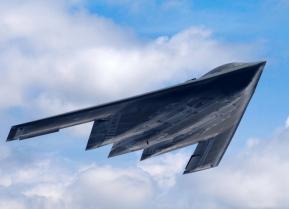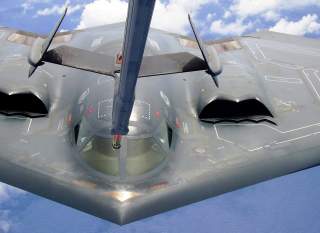Air Force Pilot on the B-2 Stealth Bomber: “It is really an awesome bombing platform."
And this is why.
As a stealth bomber engineered during the height of the Cold War, the B-2 was designed to elude Soviet air defenses and strike enemy targets – without an enemy ever knowing the aircraft was even there.
In a special interview designed to offer a rare look into the technologies and elements of the B-2, Mickelson - who flew B-2 bombing missions over Libya in 2011 - explained that the platform has held up and remained very effective – given that it was designed and built during the 80s.
(This first appeared several months ago.)
“It is a testament to the engineering team that here we are in 2016 and the B-2 is still able to do its job just as well today as it did in the 80s. While we look forward to modernization, nobody should come away with the thought that the B-2 isn't ready to deal with the threats that are out there today,” Mickelson, former director of operations for 394th combat training squadron, told Warrior Maven in an interview several years ago. “It is really an awesome bombing platform and it is just a marvel of technology.”
The B-2 is engineered with avionics, radar and communications technologies designed to identify and destroy enemy targets from high altitudes above hostile territory.
“It is a digital airplane. We are presented with what is commonly referred to as glass cockpit,” Mickelson said.
The glass cockpit includes various digital displays, including one showing Synthetic Aperture Radar (SAR) information which paints a rendering or picture of the ground below.
“SAR provides the pilots with a realistic display of the ground that they are able to use for targeting,” Mickelson said.
The B-2 has a two-man crew with only two ejection seats. Also, the crew is trained to deal with the rigors of a 40-hour mission.
“The B-2 represents a huge leap in technology from our legacy platforms such as the B-52 and the B-1 bomber. This involved taking the best of what is available and giving it to the aircrew,” Mickelson said.
The Air Force currently operates 20 B-2 bombers, with the majority of them based at Whiteman AFB in Missouri. The B-2 can reach altitudes of 50,000 feet and carry 40,000 pounds of payload, including both conventional and nuclear weapons.
The aircraft, which entered service in the 1980s, has flown missions over Iraq, Libya and Afghanistan. In fact, given its ability to fly as many as 6,000 nautical miles without need to refuel, the B-2 flew from Missouri all the way to an island off the coast of India called Diego Garcia – before launching bombing missions over Afghanistan.
“Taking off from Whiteman and landing at Diego Garcia was one of the longest combat sorties the B-2 has ever taken. The bomber was very successful in Afghanistan and very successful in the early parts of the wars in Iraq and Libya,” Michelson added.
The B-2 crew uses what’s called a “long-duration kit,” which includes items such as a cot for sleeping and other essentials deemed necessary for a long flight, Mickelson explained.
B-2 Mission
As a stealth bomber engineered during the height of the Cold War, the B-2 was designed to elude Soviet air defenses and strike enemy targets – without an enemy ever knowing the aircraft was even there. This stealthy technological ability is referred to by industry experts as being able to evade air defenses using both high-frequency “engagement” radar, which can target planes, and lower frequency “surveillance” radar which can let enemies know an aircraft is in the vicinity.
The B-2 is described as a platform which can operate undetected over enemy territory and, in effect, “knock down the door” by destroying enemy radar and air defenses so that other aircraft can fly through a radar “corridor” and attack.
However, enemy air defenses are increasingly becoming technologically advanced and more sophisticated; some emerging systems are even able to detect some stealth aircraft using systems which are better networked, using faster computer processors and able to better detect aircraft at longer distances on a greater number of frequencies.
The Air Force plans to operate the B-2 alongside its new, now-in-development bomber called the Long Range Strike – Bomber, or LRS-B. well into the 2050s.
B-2 Modernization Upgrades – Taking the Stealth Bomber Into the 2050s
As a result, the B-2 fleet is undergoing a series of modernization upgrades in order to ensure the aircraft can remain at its ultimate effective capability for the next several decades, Mickelson said.
One of the key upgrades is called the Defensive Management System, a technology which helps inform the B-2 crew about the location of enemy air defenses. Therefore, if there are emerging air defenses equipped with the technology sufficient to detect the B-2, the aircraft will have occasion to maneuver in such a way as to stay outside of their range.
The Defensive Management System is slated to be operational by the mid-2020s, Mickelson added.
“The whole key is to give us better situational awareness so we are able to make sound decisions in the cockpit about where we need to put the aircraft,” he added.
The B-2 is also moving to an extremely high frequency satellite in order to better facilitate communications with command and control. For instance, the communications upgrade could make it possible for the aircraft crew to receive bombing instructions from the President in the unlikely event of a nuclear detonation.
“This program will help with nuclear and conventional communications. It will provide a very big increase in the bandwidth available for the B-2, which means an increased speed of data flow. We are excited about this upgrade,” Mickelson explained.
The stealth aircraft uses a commonly deployed data link called LINK-16 and both UHF and VHF data links, as well. Michelson explained that the B-2 is capable of communicating with ground control stations, command and control headquarters and is also able to receive information from other manned and unmanned assets such as drones.
Information from nearby drones, however, would at the moment most likely need to first transmit through a ground control station. That being said, emerging technology may soon allow platforms like the B-2 to receive real-time video feeds from nearby drones in the air.
The B-2 is also being engineered with a new flight management control processor designed to expand and modernize the on-board computers and enable the addition of new software.
This involves the re-hosting of the flight management control processors, the brains of the airplane, onto much more capable integrated processing units. This results in the laying-in of some new fiber optic cable as opposed to the mix bus cable being used right now – because the B-2’s computers from the 80s are getting maxed out and overloaded with data, Air Force officials told Scout Warrior.
The new processor increases the performance of the avionics and on-board computer systems by about 1,000-times, he added. The overall flight management control processor effort, slated to field by 2015 and 2016, is expected to cost $542 million.
B-2 Weapons
In coming years, the B-2 will be armed with with next generation digital nuclear weapons such as the B-61 Mod 12 with a tail kit and an Long Range Stand-Off weapon or, LRSO, an air-launched, guided nuclear cruise missile, service officials said.
The B-61 Mod 12 upgrade, which has already been test-dropped from a B-2 during Air Force testing, is an ongoing modernization program which seeks to integrate the B-61 Mods 3, 4, 7 and 10 into a single variant with a guided tail kit. Also, the B-61 Mod 12 is being engineered to rely on an inertial measurement unit for navigation.
In addition to the LRSO, B83 and B-61 Mod 12, the B-2 will also carry the B-61 Mod 11, a nuclear weapon designed with penetration capabilities, Air Force officials said.
The LRSO will replace the Air Launched Cruise Missile, or ALCM, which right now is only carried by the B-52 bomber, officials said.
Alongside its nuclear arsenal, the B-2 will carry a wide range of conventional weapons to include precision-guided 2,000-pound Joint Direct Attack Munitions, or JDAMs, 5,000-pound JDAMs, Joint Standoff Weapons, Joint Air-to-Surface Standoff Missiles and GBU 28 5,000-pound bunker buster weapons, among others.
The platform is also preparing to integrate a long-range conventional air-to-ground standoff weapon called the JASSM-ER, for Joint Air-to-Surface Standoff Missile, Extended Range.
The B-2 can also carry a 30,000-pound conventional bomb known as the Massive Ordnance Penetrator, Mickelson added.
“This is a GBU-28 (bunker-buster weapon) on steroids. It will go in and take out deeply buried targets,” he said.
B-2 Composite Materials Upgrade
Materials into the upper surface of the B-2 bomber to increase the stealth aircraft’s service life, improve durability, enhance sustainment and eliminate the need for field repairs, service and industry officials said.
The new composite hot trailing edge (HTE) skin, to be added behind the exhaust nozzles on the surface of the bomber, is made up of a durable, high-temperature material more resistant to degradation from thermal and vibroacoustic stress, service developers stated.
“The Polyimide material presently used for HTE degrades quickly in this operational environment; as the incessant exposure to heat and engine exhaust exceeds its capabilities, the material cracks and the resin disintegrates,” an Air Force statement said last year.
Therefore, recognizing the need for more resilient materials, the Air Force Research Lab engineered a new application based on AFR PE 4, service information states. AFR-PE-4 is a high-temperature thermosetting polyimide resin with service capability up to 343-degrees Celsius, according to information from Maverick Molding. Maverick, a high-temperature polymer firm, says they commercialized AFR-PE-4 after it was first developed by the Air Force.
Engineers working on stealth technology designs often try to reduce the “heat signature” or infrared/thermal sensor detectability of the aircraft. The more heat a bomber gives off in flight, the more enemy sensors and radar are likely to detect it. Therefore, it seems evident that a material less prone to degradation or disintegration at high- temperatures might likely lessen the heat signature emitted from decay or erosion taking place on the aircraft.
After extensive testing and demonstrations going back several years, the Air Force and B-2 prime contractor Northrop Grumman are now moving forward with plans to produce the new composite HTE components; Northrop recently awarded a five-year, $90 million deal to Orbital ATK to manufacture 17 HTE composite parts, a Northrop announcement said. Production will take place at Orbital ATK’s Aerospace Structures Division facility in Dayton, Ohio, later this year.
The replacement showcases the coordinated efforts of personnel from AFRL, Hill Air Force Base (Utah) and the University of Dayton Research Institute (Dayton, Ohio), Air Force officials said.
Northrop Grumman’s major subcontractors on the program are BAE (receivers), Ball Aerospace and L-3 Randtron (antennas), and Lockheed Martin (display processors).
The Air Force currently operates 20 B-2 bombers, with the majority of them based at Whiteman AFB in Missouri. The B-2 can reach altitudes of 50,000 feet and carry 40,000 pounds of payload, including both conventional and nuclear weapons.
Osborn previously served at the Pentagon as a Highly Qualified Expert with the Office of the Assistant Secretary of the Army - Acquisition, Logistics& Technology. Osborn has also worked as an anchor and an-air military specialist at national TV networks. Osborn has a Masters Degree in Comparative Literature from Columbia University.
This first appeared in Warrior Maven here.


